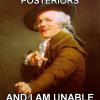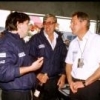OK, so 'H-pattern gearbox era' spans a hell of a long time, and I won't attempt to tie down a start date - but we know that in GP racing, aside from the odd pre-selector gearbox equipped car and cars like the Lotus 76, every car on a GP grid had three pedals and a H-pattern gearbox up to the end of 1988, slowly declining with the introduction of the semi-automatic gearbox and sequential shifter until Forti's FG01 ditched it's manual gearbox and went semi-auto during 1995.
I have read many snippets of info and heard interviews etc. over the years about drivers 'driving without the clutch' during a race, due to clutch failure. The common theme being, they sometimes shifting gears without the use of the clutch pedal - the clutch itself was still transferring drive from the engine to the gearbox, just that it could not be disengaged by the pedal. But that was the exception rather than the rule during racing. However was there any point in time before H-pattern boxes were phased out, when the clutch pedal wasn't needed to be pressed to get a clean shift, at least with some cars? Watching onboard cameras over the years, at least from the mid-80's onwards it appears that some drivers were't using the clutch in a healthy car, at least on upshifts. There are of course some videos out there where it was obvious the clutch pedal was still being used - Patrick Depailler at Monaco with the bodyless Tyrrell P34 for AFAVA in '77, Ukyo Katayama at the Japanese GP in '93 where a foot cam was installed (I think the Tyrrell 021 was a sequential gearbox car as well).
It's not GP racing, but the few modern H-pattern equipped single seaters that are aout there - mainly Formula Ford cars - don't need the clutch pedal once the car is rolling. So was there a point where some gearboxes on Formula One cars became developed enough that it was possible to regularly shift without the clutch pedal?
My personal experience is limited to me being lazy in some road cars - perfectly possible to shift without the clutch pedal, but I never done it with the throttle wide open...

















